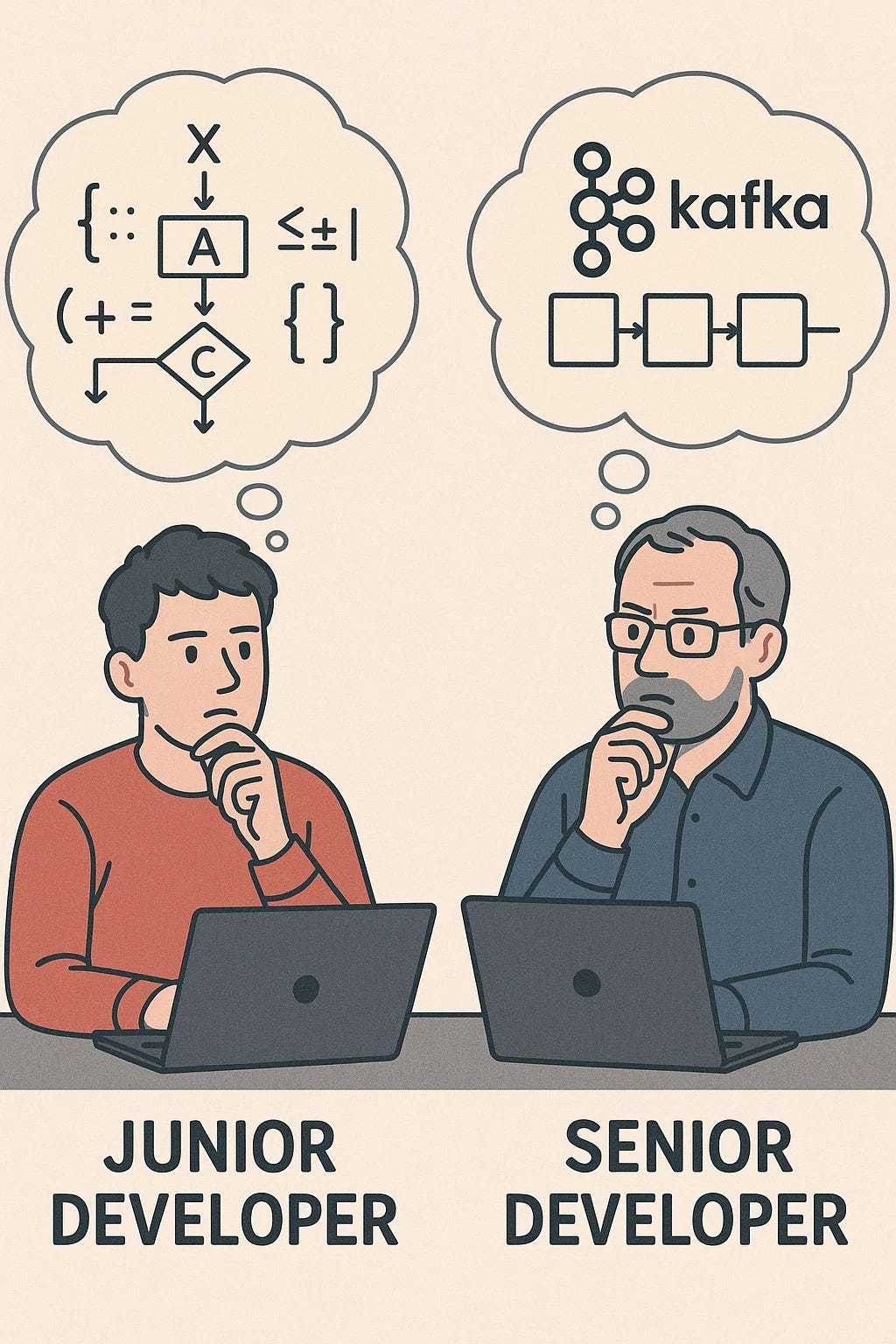It’s not just about solving problems — it’s about how you think through them

I’ve asked myself this question a lot of times — how do I reach the kind of thinking senior developers have? What makes them different? And over time, I’ve started to believe that one of the key reasons someone becomes a “senior” developer is in how they approach solving problems, not just solving them.
Recently, I was talking with some friends — we’re all junior or associate developers — and one of them was working on a POC. The task was to collect user events using a session-id, and store those events grouped by that session ID in the cloud or some kind of storage. Since these events are huge and come in high volume, compression was required before storing them.
Now, as expected, the discussion got into the usual frontend vs backend debate. Who should do what? What belongs on the frontend? What should be handled by the backend? Eventually, we agreed that the frontend would send the events with the session ID, the backend would compress and store them, and then later, the backend would send the compressed blob back to the frontend, which would decompress and use it.
“Frontend vs backend is the dev version of ‘who’s doing the dishes.’”
Where Things Got Tricky
Everything was fine until we hit a real-world scenario that we hadn’t planned for. What if all the events don’t arrive in a single request? Like say, the first request sends 4 events with a session ID. We compress and store them. But later, another request comes in with more events for the same session ID.
That raised a bunch of new questions:
- Should we retrieve the existing compressed blob, decompress it, add the new events, recompress it, and store it again?
- Should we hold off until we get all the events?
- What about the order of the events? Ordering matters — how do we maintain that?
We started throwing out ideas. Everyone was suggesting their own version of compression/decompression workflows. Some were interesting. Some were kind of clever. But honestly, it started to feel like we were solving this like a DSA problem — writing logic-heavy, code-driven approaches that only made the whole flow more complex.
“Sometimes I think I’m solving architecture problems, but I’m just speedrunning LeetCode in production.” 😅
Then, someone suggested we ask a senior dev for their take.
The One-Liner That Changed Everything
We explained the situation to them, and after hearing us out, they said something super simple:
“Why don’t you just use a message broker?”
That’s it. One line.
The moment they said that, it just made sense. A queue system would’ve solved everything neatly — handle incoming events asynchronously, preserve ordering, and allow easy scaling. We were so deep into programmatic logic and patchy fixes that we didn’t even think of using services like a message broker.
And that’s when it hit me. This is the difference.
We were solving a technical problem, sure. But we were doing it like we were still in algorithm class. Trying to solve a backend system problem with nested loops and logic trees, rather than looking at the bigger picture.
“You’re not gonna believe this, but that’s not the smartest way to solve it, Morty.” — probably that senior dev
A senior developer looks at problems differently. They’re not just trying to solve it — they’re trying to design a solution that lasts. One that’s scalable, reliable, flexible, and doesn’t need to be refactored every other sprint.
We juniors always try to provide a solution. And that’s not wrong — it’s actually a good sign that we’re thinking and trying to understand the problem deeply. But often, we lack the experience to know what it takes to implement that solution in a way that’s production-ready, future-proof, and maintainable.
A senior developer doesn’t just write code. They think about the entire lifecycle of that code. How extensible it is. How it scales when the user base grows. How reusable it is across other modules. It’s not just about getting it to work for one use case — it’s about designing it so it works for many.
“Any fool can write code that a computer can understand. Good programmers write code that humans can understand.” — Martin Fowler
And I think that’s what this journey is about. Slowly understanding why things are built the way they are, and not some other way. Asking “why not this?” or “can this be improved without breaking the rest?” becomes second nature over time.
This field is constantly evolving. New tech, new tools, new problems. That’s the game. You’ve got to be learning every single day. Keep experimenting. Try out new implementations for the same problem. Don’t hesitate to ask seniors for feedback. And most importantly, keep asking yourself — do I really understand what I’m doing and why I’m doing it this way?
If you’re doing that, you’re already on the right track.
“Wubba Lubba Dub-Dub!” — in dev terms: I’m in great pain, please review my PR.
Stay curious, and stay hungry. And for more of this kind of stuff, visit https://mayhemcode.com—more content coming soon.